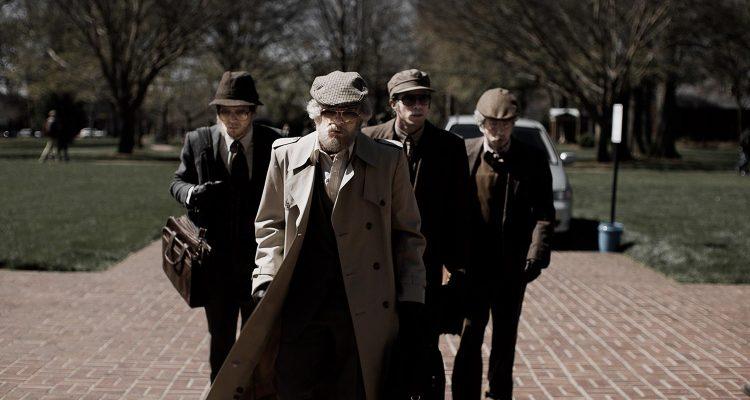The most any one of us will ever know about pulling off a heist in real-life would be relegated to the movies we’ve seen. Classics such as “Dog Day Afternoon,” “Ocean’s Eleven,” “The Sting,” “The Killing,” “Heat,” and “Reservoir Dogs” have cemented an image, moments, of how it could be done, but suffice to say, those are just movies. As “American Animals” points out, the fluid, professionally conceived robberies we’ve been accustomed to in cinema are a figment of our imagination. The four uninformed college underachievers in director Bart Layton‘s film have been fed the fiction of the aforementioned classics, so much so that at some point in the film they have a stack of a dozen or so heist movies on their table, watching each one of them, even giving themselves color coded nicknames such as “Mr. Pink,” and “Mr. Black.” Of course, the disconnect between reality and fiction is very apparent in these dweeby, immature “boys.”
READ MORE: Sundance 2018: The Most Anticipated Films Of The Festival
Layton’s film is based on actual events, which had four Kentucky students attempting a $12 million dollar heist at their own college library, with the valuable literature they tried to snatch including an original copy of Charles Darwin’s “Origin of the Species” and John James Audpbon’s “Birds of America.” Layton, quite unsubtly might I add, uses those classic books to showcase all-too-easy metaphors about the connection between man and animal.
Layton, whose riveting 2012 Sundance-debuting documentary “The Imposter” mixed fiction and non-fiction to tell the true story of a con artist, is fascinated here again with the themes of what’s real and what isn’t, but fails to capture the same griping immediacy. In “American Animals,” Layton occasionally interviews the real perpetrators — Spencer Reinhard, Warren Lipka, Eric Borsuk and Chas Allen — who appear to flesh out the drama that’s onscreen. Barry Keoghan, Evan Peters, Jared Abrahamson and Blake Jenner play the fictional versions of the robbers and they do a commendable job with their respective roles. However, the decision to have the real-life players appear as well is problematic as it consistently kills any kind of flow the movie might have had dead to the ground. The random cuts into the non-fiction, talking-head realm throughout the film is unnecessary and abrupt.
Of course, the fact that the real-life criminals being interviewed keep questioning the events and motives being depicted onscreen adds a whole other layer of to the film, but it also does a disservice to the setup which, quite honestly, is by-the-books and doesn’t bring anything new to the tired heist genre.
Reinhard, played impeccably by Keoghan, wants to steal the prized artifacts because his life is dull; he feels numb and uninspired inside his own self. It’s not like he isn’t a bright guy. He’s a smart, talented fine-arts student that enters Kentucky’s University of Transylvania hoping for a moment of enlightenment. That moment only comes when he meets Lipka, who is an equally unmotivated student, but also highly toxic and dangerously walks a tightrope.
The scheme they both concoct is so ludicrous that without even knowing about the true story, the audience knows it is doomed to fail. Reinhold and Lipka keep mentioning that they are doing it for the “adventure” and Layton lays it down pretty thick the white male privilege of these individuals. The entrance of Borsuk, studying accounting and wanting to join the FBI post-grad, and Allen, a well-off athlete who has no business doing the heist, raises the stakes and showcases how easily reality and fiction start to blur in seemingly simple, but isolated suburban lives.
Of course, all four actors are perfectly fine here, but the set-up is predictably conventional. The way Layton decides to take his time and build up a clichéd setup filled with such tropes as the token assembling of the crew and the meticulous planning of the heist, is frustrating. There isn’t much of interest for us in that first hour because, truth be told, we’ve seen characters like these before and there’s no sympathy whatsoever to be had for their “misfortunes” in life. They have it made: White, in college, parents with moderate to good incomes. We feel no pity or remorse for them.
Yes, the heist itself is breathtakingly delivered, as Anne Nikitin’s electronica score and Ole Bratt Birkeland’s frenetic camerawork bring us smackdab in the middle of the claustrophobic action. The exquisitely edited library robbery, which encompasses around twenty or so minutes of screentime, is a sheer, visceral delight. The rest of “American Animals” could have used that same stylishly electric jolt but resorts instead to a forgettable mashup of pedestrian and, familiar genre tropes. At the end of the day, these real-life people did not deserve to have a movie made about them. [C]
Click here for our complete coverage from the 2018 Sundance Film Festival

